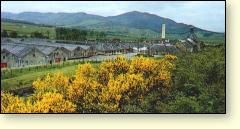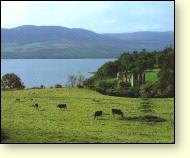
 |
|
Location: Edderton, Tain, Ross-shire IV19 1LB
Hours: 10am - 12 noon, 2pm - 4pm, Mon - Thur
All visits by appointment · Group bookings, max 8
No reception centre
Phone: 01862-821273
Homepage: www.inverhouse.com
|
This is Ross-shire, the old territory of the Clan Ross, so it is appropriate that a well-known local whisky-making family of the same name had much to do with running the two distilleries called Balblair. Today it is claimed to be the second-oldest distillery in Scotland. Edderton lies just up the A9 from Glenmorangie and has a similarly beautiful setting overlooking the shore of the Dornoch Firth. On the opposite shore lie Spinningdale, where Mackintosh produced coats from his new waterproof material, and Dornoch, where the ‘last witch in Scotland’ was burned in 1722. The second Balblair construction was a continuation of the business and, with its stone-built, Victorian neatness, is one of the prettiest little distilleries in Scotland.

Spinningdale, the home of the Mackintosh, lies across the Dornoch Firth from the Balblair Distillery.
|
Distilling at Balblair enters the record in 1749 but 1790 is given as the founding of the distillery. Even this is an early date since few of today’s distilling names were in existence before the turn of the 19th century. In the 1860s, Andrew Ross’s son, John, went down to Alness to work the Teaninich distillery and Balblair was rebuilt about half a mile away from the original site. The new buildings were on higher ground so that use could be made of gravity in working the distillery, but also to be closer to the railway line. The old buildings down below became warehouses.
The distillery was closed from 1915 to 1947 when it was bought by a Keith solicitor called Cumming who also owned Pulteney distillery up at Wick. Balblair was sold to Inver House in 1996 having been owned by Hiram Walker
The water used in production comes down from lochs high in the hills nearby. Balblair’s owners supply their own barley seeds to farmers in Fife so that they can have maximum control over pre-production factors. Edderton is surrounded by peat that goes light and crumbly when seasoned, helping to impart finesse and subtlety to the final whisky. Appropriately, the village is known as ‘the parish of peats’.
This is a fine example of a small, country distillery and the buildings are pretty well as they were at the end of the 19th century; the long closure from 1915 helped things remain intact. On-site malting ended in the mid-1970s but the old steeps and part of the building are still in place. One of the washbacks was brought from Ardbeg distillery on Islay and one of the three stills is finished with rivets, which is the old-fashioned method of sealing seams on stills.
The Whisky
Balblair is bottled at five and ten years old with 40% vol. It is typically light with medium peat presence; spice and a consistent bite show through at all ages. Some 1959, 1964 and 26-year-old have recently been offered by the independents, plus another 10-year-old from different wood from that used at the distillery. Balblair is used in Ballantine’s Scotch blends.
Source of water
Struie Hill
Of interest
· Croick Church at Ardgay became the refuge for tenants evicted from their holdings by landowners during the Highland Clearances in 1845 to make way for sheep. Ask to see the names the refugees scratched on the east window at the time.
· Carbisdale Castle, which looms imposingly above the forest to the north-west, is probably the grandest youth hostel in Europe.
· The Falls of Shin near Lairg give a grandstand view (at the right times of the year) of salmon leaping and often actually swimming up the tumbling, white-water cascade.